January 3-7, 2024: We spend four nights on a mooring ball at John Pennekamp State Park.
After bouncing around in wind-generated waves and swells on the ocean side of the Florida Keys for nearly two hours, we cruised into Largo Sound. I had reservations for five nights on a mooring ball there that was part of the John Pennekamp State Park marina facility. Jason grabbed the ball this time and we were tied up within just a few minutes.
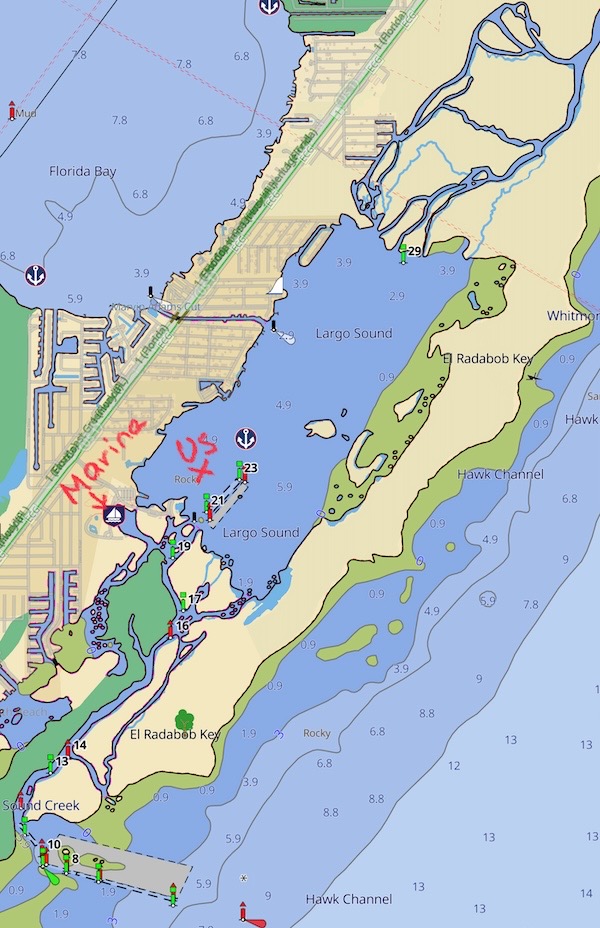
Here’s the Aqua Map display of Largo Sound and its surroundings. We came in through the channel on the south. The Waterway Guide marina icon is now in the correct position; I sent in a correction and they fixed it promptly.
Getting to Know John Pennekamp
We had lunch before doing anything else. I’d been ready for lunch before our walk around Indian Key but finding the boat in rough water on our return made it nearly impossibly to just hang out and have lunch before continuing our trip. So I made a big lunch: eggplant sautéed with garlic in olive oil and then baked onto bread rounds with goat cheese on top. (I call them eggplant pizzas.) It was a little late in the day for such a big meal, but we were hungry. Later, around dinner time, we’d snack.
We loaded up the dinghy and drove over to where the marina was. Or where we thought it was. You see, the position icon in Waterway Guide, which is overlaid on Aqua Map, was wrong. It showed the marina where there were actually homes. In reality, the marina was on the far side of a handful of beaches and a park road. The real way to get to it was to follow the channel out of the sound, through some mangroves, and down another channel. The distance had to be about a mile from the boat.
But that’s not how we got there the first time. Instead, we headed for a kayak launch beach at the edge of a No Motor zone. We motored until the water got too shallow, killed the motor, pulled the prop out of the water, and glided in. (Over the next few days, I’d actually do a lot of rowing in that area when I saw manatees around. It was just too long a ride in the dinghy to take my pups to the marina several times a day. The kayak beach and adjacent area was all they needed. And there were garbage and recycling bins there, too, so it was a convenient garbage stop, too.)
We put my pups on leashes and went in search of the dockmaster to check in. That’s where we found the actual marina office and the slips they also rented. I checked in, got a piece of card stock with my Sharpied departure date and masking tape on it to attach to my boat — with no thought of how I’d actually get it back in a dinghy — and got directions to the showers, which were farther away, in the campground.
This is not your typical cruiser facility. It was rough, to say the least. It explains why there was never more than one other cruising boat on the mooring balls with us and only one at the slips.
They also didn’t have a map of the park, although we eventually found one online.
We went back to the boat and had a restful afternoon. I did some reading. We had a nice sunset with lots of red clouds.
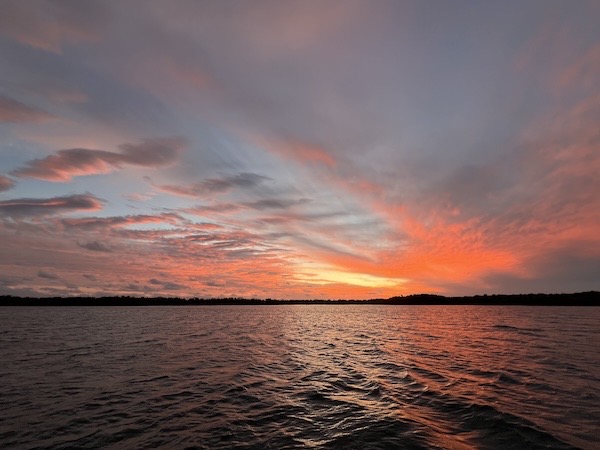
Mother Nature treated us to a nice sunset with lots of color in the sky.
For dinner, we snacked on cheese, crackers, and Trader Joe’s canned eggplant with tomatoes. Later, we watched a documentary on TV about Henry Flagler’s Railroad on YouTube.
Exploring the Mangroves
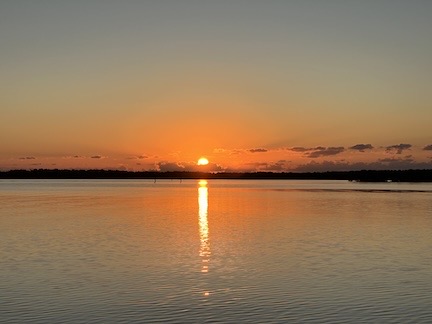
Sunrise on Thursday was a treat, too. I didn’t expect the sky to be so clear or the water to be so calm.
I woke Thursday after an excellent night’s sleep. It had been calm and quiet all night. No stress about the mooring ball dragging, either.
We took my pups to the kayak beach for some quick business and then went back to the boat. I made veggies and eggs for breakfast.
We decided to take the dinghy out the west channel to the bay side — just to check it out — and then explore the mangrove channels on the north end of the sound. We left my pups behind, but did bring the 2 gallon gas can. My dinghy’s Suzuki 6 hp motor has a built-in 0.7 gallon fuel tank, but that’s usually not enough fuel for a long ride. I figured we could always refuel every time we ran out of gas.
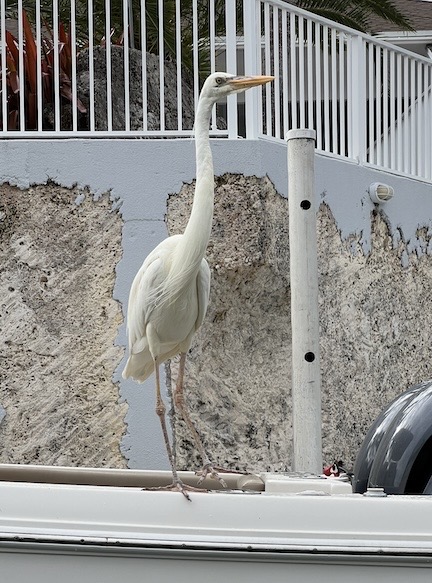
This egret was perched on a boat alongside the channel as we cruised back out into the sound.
The west channel was a cut through solid rock with homes on either side. It had a strong current, but the dinghy was able to fight it and bring us out to the bay side. Only a few days before, I’d been fighting wind and waves out in that bay, trying to find a decent anchorage for the night. It was a lot calmer that day. But having no where of interest to go out there, we turned around and retraced our path back to the sound, now with a 1.5+ mph current in our favor.
We headed up to the north end of the sound, running out of gas along the way. The water was pretty calm and Jason topped off the tank without spilling a drop. Then we followed the main channel north. Mangroves lined each side of the channel. The water was clean and I could see the bottom most of the time; it was a maximum of 8 feet deep, I think. One boat passed us — a fishing boat moving slowly with three people on board.
We made a left off the main channel into a narrower channel. Now the mangroves closed in tightly, making a very narrow path. While Do It Now could have made it down the main channel, this one was just too tight.
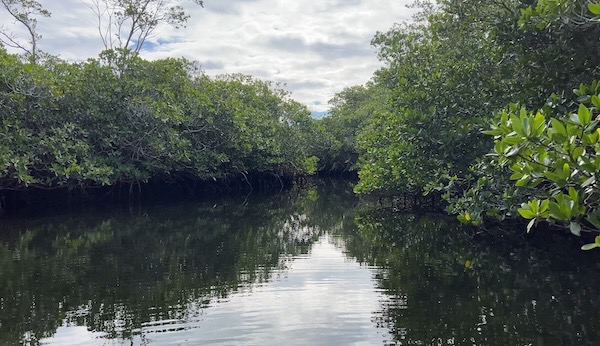
Believe it or not, we were able to get down this narrow channel. It was fun being in the mangroves, cruising slowly in my little dinghy.
We spent the next hour or so exploring the narrow channels. We had to turn back twice, but still managed to explore a lot of places. I kept a sharp eye out for manatee — this is their habitat — but didn’t actually see one until we passed a tour guide on a patio boat pointing a pair out to his paying passengers. We stopped the engine and drifted nearby as the mother of the pair drank fresh water draining from the tour guide’s cooler.

The mom is drinking; her nearly full-grown calf is beside her. Later they separated and swam around us while we drifted, just watching.
Eventually, the manatee left and so did we. We headed back toward the boat. The weather had turned windy and there was a good chop on the water. We ran out of gas again and Jason filled it again.
We got back to the boat around lunchtime. We had leftover pork chops made into sandwiches. I spent the afternoon working on accounting chores on my computer and starting my Key West blog post. I got dinner started before we motored back to the marina with the pups for a walk and showers. (The showers, by the way, weren’t anything fancy — heck, it was a state park campground, after all — but they met two important requirements: the water was hot and the pressure was good.) Then back to the boat for dinner — chicken mole with rice — and computer stuff. Jason worked on his blog.
The weather had been pretty good most of the day, despite the wind that came and went. I was pleased to see that the solar panel seemed to be keeping up with our battery usage.
A Few Short Hikes and Trip into “Town”
Just as the forecast had predicted, it was windy on Friday. I started the day as I usually do, with coffee and puzzles in bed. When it got light enough to see, I took my pups to shore while Jason made us eggs with the leftover mole sauce for breakfast. It was excellent.

This single purple flower grew out of a vine above our heads on one trail.
Later, we dinghied back over to the marina, where we left the boat. After a short, disappointing trip to the “visitor center” — a building with fish tanks and a donation station — we checked out the two trails that wound through the woods within the park. I don’t know if it was because it was winter or it was because the forest is of the half-dead variety, but neither of the two walks were very interesting. One dead ended at a mostly torn out historic orchard and the other looped through an area with interpretive signs that could not be easily matched to the vegetation they were trying to identify.

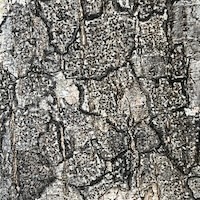
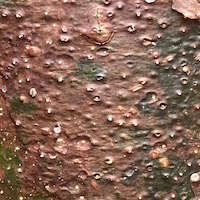
One of the things I found fascinating on our second trail walk was the textures of the barks on several types of trees. Don’t ask me to identify these.
Again, I got the overall feeling that the park was neglected or in decline. I couldn’t remember much about my previous stay in the campground 30+ years before, but I know my general impression of the facility had been a lot more positive. What had changed in 30 years? The park or my bank of experiences to judge things? Probably both.
From there, we headed out of the park on foot. There was a West Marine within a mile and a Thai restaurant Jason had found on Google that looked good for lunch. Along the way we stopped at a gift shop where I bought a replacement wind sock for my old one, which had become so weathered and torn that I had to throw it away, and a t-shirt for Jason’s belated Christmas present. At West Marine, I was looking for some kind of cap and hose system to convert my little fuel can into a tank I could attach directly to my dinghy motor, but came up empty; I’ll have to buy a special gas gan for that and I simply don’t have space to store it. I did walk away with a new pair of water shoes and a wrench to adjust my pesky packing nut and Jason bought a new travel towel.
Next was lunch. We stopped at Num Thai Restaurant and Sushi Bar. It was a great place with very good food and funky food delivery robots. I highly recommend it.
We stopped at a not very good health food store, looking for rice and coming up empty (if you can believe that). Then we stopped at a donut food truck for dessert: “fresh made” maple bacon (for me) and key lime coconut (for Jason) donuts. (This is the second time I’ve had something like this. They make plain donuts and then cover them with a shitload of sugary topping when you place your order.) They were good but very, very sweet.
Back in the park, the wind had whipped up and the water was rough. We got back to the boat without getting too wet. I spent the afternoon relaxing, reading Wired magazine, and catching up on social media. (I should have been writing.)
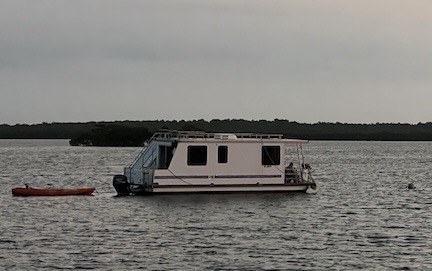
Here’s that houseboat tied to a mooring ball on one evening.
Later, we replayed the previous night with a trip to shore with the pups for a walk and a shower. Jason went for a run, too. We got pretty wet coming back in the choppy water. By that time, a sailing catamaran had tied up at one of the mooring balls and, before dark, a funky little houseboat that had been drifting around the sound all day tied up to another ball. (I suspect he was squatting at night on the balls, because he wandered around all day and came back to a ball the following night, too.)
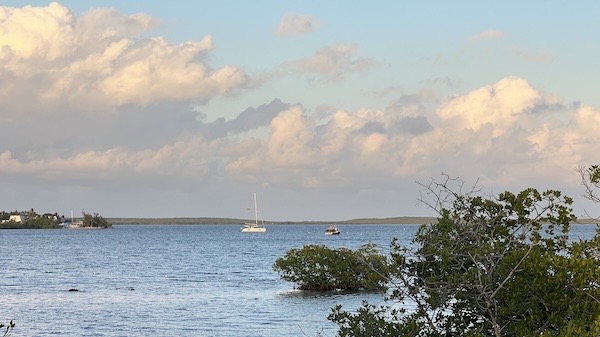
Here’s a shot of the mooring field from the park on our evening walk. By that time, the sailing cat had tied up but the houseboat was still wandering around the sound.
I made scallops with aromatic vegetables and a Trader Joes couscous blend for dinner. It was good.
Power Concerns, Blogging, Rest and Relaxation
It was windy and the water was rough all night. One of the things about anchorages that take getting used to is the sound of the slap of water against the front of the hull when the water is choppy. Another is the constant boat movement. Not all anchorages are like this, but this one, in a big open area, was. Ironically, we’d come there for a protected anchorage and the only thing we’d gotten was a secure mooring ball — no dragging anchor — with access to trash bins and showers.
I slept pretty well despite the noise and movement. When I got up to make my coffee, I found the battery level down to 11.5 volts, which is not good. There hadn’t been enough sun the previous day to juice up the batteries and the refrigerator was wearing them down. I made coffee on the stove with the kettle and drip do-dad Jason had bought me for Christmas. Afterward, I ran the engine for about an hour to get the batteries back up. (According to the engine computer, that burned about 1/2 gallon of diesel.) The inverter told us that power levels were at 12.2 volts when I shut the engine back down. I hoped for sun and started thinking again about a wind generator.
Keep in mind that I had a Honda portable generator under the aft deck. In a dire emergency — like if I couldn’t start the engine — I could pull that out, put it on the deck, and run it. But in the 18 months it had been on the boat, I hadn’t used it once and I didn’t plan on relying on it now. I hate generators and the noise they make. (And no, running the engine isn’t a good solution, either.) I plan to bring the generator home when I drive back to Washington in April. I’d prefer to upgrade the boat’s solar setup and add a wind generator — if I can find a reputable person do do the job right.
The fact that battery power levels had crept down so low did not surprise me. We’d been on the mooring ball for three nights; the last time this had happened was at Peck Lake after three nights and partly cloudy days. It appeared that my limit was three nights and I had to just accept that. Unfortunately, we had one more night to go — we’d already decided to leave on Sunday, which gave us a good weather window for a cruise to Miami. That’s why I ran the engine to bring the charge back up a bit.
We had cereal with fresh strawberries for breakfast. I took my pups to the beach by myself — I can get the dinghy on plane when it’s just me and the girls on board and getting on plane makes it possible to move quickly without getting too went in choppy water. I finished my Key West Blog post.
Later, we went into the park with my pups to try another trail: a boardwalk that ran through the mangroves. Unfortunately, the trail was closed off after a few dozen feet; storm damage had destroyed the boardwalk and it had never been repaired. Again, I got the feeling of neglect, like no one really cared enough about the park to keep it in good shape.
So we walked to Cannon Beach instead. The beach, which we could see from the boat, gets its name from the four cannon positioned along the beach pointing out into the sound. There are parts of a shipwreck in the water about 100 feet from shore — a place for people to snorkel to. There were quite a few people on the beach that Saturday despite the clouds and wind.
I should mention here that John Pennekamp Coral Reef State Park is a destination for snorkeling and observing sea life. From its website:
The first undersea park in the U.S., John Pennekamp Coral Reef State Park encompasses approximately 70 nautical square miles. While the mangrove swamps and tropical hammocks in the park’s upland areas offer visitors a unique experience, it is the coral reefs and their associated marine life that bring most visitors to the park. Many enjoy the view of the reef from a glass-bottom boat tour, but visitors can get a closer look by scuba diving or snorkeling.
The last time I’d been there, we’d done a glass bottom boat tour. It was also the first place I ever went snorkeling. I have fond memories of it for that. But on this trip, the water was rough — so rough, in fact, that boat trips had been cancelled because of sea conditions on Saturday. It wasn’t hot enough for me to get into the water and even Jason, who likes to swim, wasn’t enthusiastic about snorkeling there. We’ve both snorkeled at better destinations and did not want to be disappointed with the experience at the park. So snorkeling around a bunch of ship parts dropped into shallow water to provide a tourist attraction was not appealing at all.

I hung my new windsock from my antenna where the old one used to be. I used to have it on a taller pole, but it just made it more challenging to get under low bridges.
So we battled the chop in the dinghy and went back to the boat. We had some sardines with salad for lunch — we both love sardines in olive oil — and I worked on blog posts all afternoon, taking a break only to hang my new windsock.
The guy from the catamaran dinghied over on his way back from the marina. We chatted for a while. He claimed he’d dove the mooring ball line — the water was less than 10 feet deep in the mooring field — and saw evidence of it being stretched. He seemed concerned that it would break in all the wind. He’d reported it to the marina staff but they didn’t seem concerned. (No surprise there.) He said he was thinking of moving to another ball but they were all probably the same. We told him we had an anchor alarm on and advised him to do the same. He said he did and left us. Meanwhile, that houseboat was still wandering around the sound, probably fishing. It would return that night after the park staff went home.
Near sunset, I took my pups back to the kayak beach for a potty break — there were manatee swimming around the kayakers there — and made us some jambalaya with sausage and shrimp for dinner.
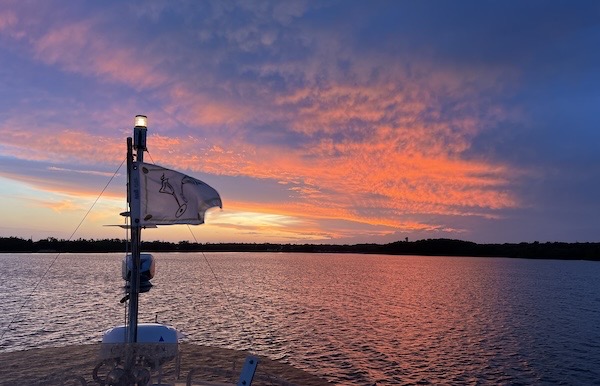
We had another nice sunset on Saturday.
We went to bed early. It rained hard overnight.
Casting Off
I woke at 4:30 the next morning. It was dead calm. The water was mirrorlike. The power in the boat’s house bank of batteries was down to 10.5 volts — not even enough to start the inverter. I didn’t realize it at first, but the refrigerator had shut down.
I made coffee on the stove — as if I had any other choice. I was very worried about the batteries. They were only a year old and I knew that letting them run down too far could ruin them. Until it got light out, I did whatever I could to minimize power usage, trying not to use the sink (water pump) or lights.
By the time it started getting light, I was very worried. Whenever we did use the sink, I could hear the pump laboring as if it couldn’t get enough power to run. The lights, when we turned them on, seemed dimmer. I was convinced we were going to ruin the batteries. I was mentally kicking myself for not running the engine for another hour before turning in for the night.
I started the engine and took my pups to shore to do their business. I got the dinghy up on plane in that perfectly smooth water. What a joy! They did their business and I dropped off the last bag of trash and recyclables. I sped back and gave the dogs their breakfast.
There didn’t seem to be any reason to stick around. We had more than 50 miles to travel that day to get to Miami, hopefully before the forecasted weather change of high winds in the area. May as well leave then and there.
So at 7:10 AM, Jason released us from the mooring ball and I eased us out of the mooring field and into the channel.
Yes, we’d cut our five night stay short by one day to get to Miami before rough weather set in, but I’d honestly had enough of John Pennekamp State Park.
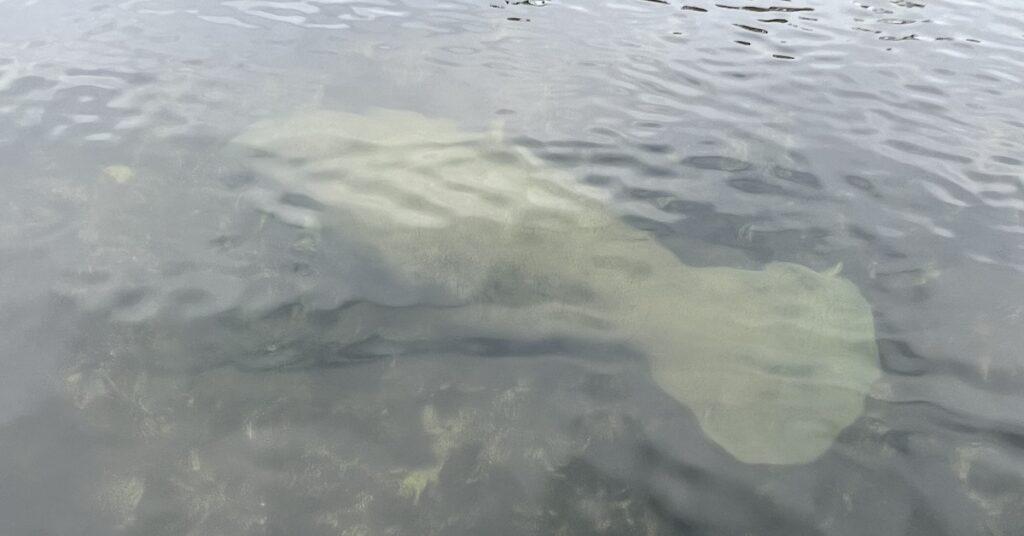

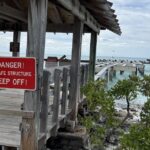
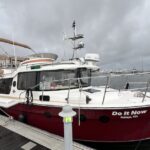
Brings back memories – The sound of those pumps is almost like another alarm system. They help you know when things are not quite right.
My fresh water pump has all different sounds it makes. The one that bothers me most: air in the lines, which can happen if you let the pump go dry. It sounds worse than an RV pump.
Nice write up, I thoroughly enjoyed reading it.
Yup, you need another solar panel, and maybe a wind generator too. Power independence is something that would give you that “no worries” feeling! Is there room on your tug for another panel? Would you need a new controller too? Then there’s the battery bank capacity to think about as well. Lot’s to consider.
Take care, have fun, sleep well.
That’s the problem. My controller can only handle a 200w panel. I have a 160w panel. I don’t think it’s worth adding just 40w. I’d rather bring it up to 400w with a new controller. Pulling my existing panel and replacing it with a higher capacity panel would fit. But I’d still need the new controller. I think it might be more worthwhile to add a wind generator which would be able to generate power 24 hours a day, no matter how much cloud cover there was.
I don’t think I need to mess with the batteries. If I could keep them topped off (or close to it) every day, I’d be fine. This boat really doesn’t use much power. The fridge is the big draw. I don’t usually have battery issues until after 2 nights at anchor. Driving for 3-4 hours replenishes the batteries for another 2 nights. But I’d like to be able to stay longer at good anchorages or cruise for shorter periods between them.
I get it.
By the way, I just booked a flight to Punta Gorda to look at a Mainship 34 on Monday. I have an agreement pending personal inspection and then the surveys. I may be a boat owner by the middle to end of February. Nice looing boat… in the pictures. We’ll see.
I’ll need to look at batteries and solar too. It has 300 watts of solar now. No idea of the wiring or battery set up. Does have a small inverter, but only 400 watts.
Wish me luck!
You’ll definitely have to update the inverter — unless there’s a generator on board. I think mine is 1500 and that’s enough for my coffee maker and microwave, but probably not at the same time. Good luck! I hope it’s a good one.